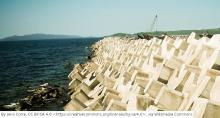
The course on Coastal Engineering is included in the study plan of the master degree program in Off-shore Engineering at the University of Bologna. The part of course that I am teaching counts 12 hours of lectures. The teacher will make extensive use of interactivity, with the options illustrated below. Lectures include about 4 hours dedicated to solving exercises by using the personal computer, by collaborative work by students and teacher. Students will be kindly asked to bring their own personal computer to solve the exercises. Students are kindly advised to speak with me if bringing their own personal computer turns out to be not possible. The purpose of the course is to provide an overview of techniques for preserving and recovering beaches and the shoreline in the presence of human impact.
The target of the course is to learn how to design and manage beach and shoreline infrastructures and preservation strategies. The course will focus on the forcing induced by sea waves and the resulting beach morphodynamics; the impact of climate change will be discussed as well as techniques for increasing the resilience of ecosytems.
The virtual room of the course can be reached here.
The teacher will make extensive use of interaction with students, to integrate the traditional one-way flow of knowledge from teacher to student with a feedback flow from student to teacher and a cross flow among students. The target is achieved by assigning an active role to the student during his/her education. Innovative teaching methods may include:
- Videos of the lectures available online in the public domain;
- Short presentations by students;
The tutorials for the course will be delivered in the form of open web pages, open media and freely accessible videos of all the lectures, for the sake of developing academic education through fully open information. Tutorials will be updated while teaching through collaborative work with the students (see below).
Tutorial web pages for the lectures:
- Coastal Engineering - The learning process adopted in the course
- Coast management and beach design - Premise
- Beach hydrodynamics and morphodynamics
- Sea wave monitoring
- Nature based solutions for coastal protection
Tutorial web pages for the practical exercises:
- Short introduction to R and R Studio
- Exercise: application of the CERC formula. Data files reporting the geometry of the shoreline and the wave forcing. Example of R file.
The videos of the lectures are available at the link below: Playlist of Coastal Engineering 2023. Videos will be made available within one week after the lecture.
The calendar of the lectures is given here below. Lectures are delivered in Ravenna, at the Ex-Asili, Via Tombesi dell'Ova from 15 to 19 (15:00-16:30, 16:50-18:20) and will also be delivered in a Teams channel that will be communicated later.
- September 22, 4 hours
- September 29, 4 hours
- October 6, 4 hours
Learning outcome will be assessed through an oral examination. The exam typically lasts for about 20-30 minutes and is articulated through 3-4 questions. The teacher may require to provide written response to one question and may ask to develop simple exercises in written form, involving simple calculations. One question aims to assess the ability of the student to deliver a clear and well articulated presentation (this question could be addressed with an interactive activity). Questions are related to the topics that are taught during the lectures and are described in the supporting documents. The teacher may ask questions not directly related to what has been discussed during the lecture in order to assess outstanding capabilities of the student to integrate the notions delivered by the teacher. The highest score (30/30) is reserved to students who demonstrate a full knowledge of the notions, a very good ability to address questions through an efficient synthesis, and a very good presentation. The laude is reserved to students who demonstrate exceptional motivation and integrate the course content with additional notions by following their personal interest and attitude. Exam dates will be scheduled as follows: one in December, two in January, 1 in February (other dates will be given later on). Exam dates will be scheduled in agreement with the students.
The teacher is available to provide clarifications on request, by receiving individual students or groups. Teacher can be contacted by email and will receive students after the lectures.
- 182 views
